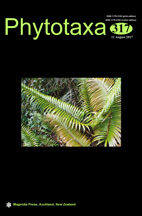Abstract
A new mycoparasitic fungal species, Tuberculina photiniae sp. nov., is proposed based on morphological and molecular evidence. The species is characterized by its depressed hemispherical pale lilac to greyish purple sporodochia breaking through leaf surfaces, septated conidiophores with vinaceous lower parts and colourless upper parts, and the presence of colourless globose, subglobose or scarcely wide-ellipsoid conidia. Sequences of ITS and LSU nrRNA gene regions of the studied samples were generated, and phylogenetic analyses were performed with maximum likelihood, maximum parsimony and Bayesian inference methods. The phylogenetic analysis based on molecular data of ITS sequences showed that Tuberculina photiniae belongs to the Tuberculina-Helicobasidium clade and is closely related to H. longisporum and H. mompa. Further investigation was carried out for representative taxa in the Tuberculina-Helicobasidium group based on ITS+nLSU sequences in which the results demonstrated that the new species formed a monophyletic lineage and grouped with H. longisporum and H. mompa. Both morphological and molecular evidence confirmed the placement of the new species in the Tuberculina-Helicobasidium clade.

